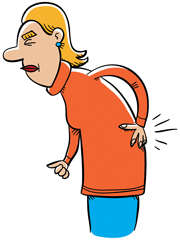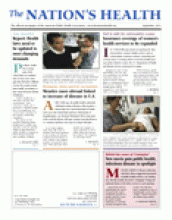For anyone who has ever spent a weekend moving into a new place, “oh, my aching back!” is a familiar refrain. According to the North American Spine Society, at some point just about everyone will suffer from some type of back pain. But while anyone can get back pain, there are some things that increase your risk, such as getting older, poor physical fitness, being overweight and heredity. What you do for a living can also increase your risk. For example, a job that requires you to bend or lift all day can lead to back pain.
“Back pain is the second most common reason anyone sees a physician, and is the No. 1 cause of disability under the age of 45,” says Heidi Prather, DO, an associate professor of physical medicine and rehabilitation at Washington University School of Medicine in Saint Louis.
Photos and art courtesy iStockphoto: Doctor, Alexander Raths; moving men, Mark Stay; cartoon woman, Brett Lamb
From a prevention standpoint, one of the most important things you can do to head off back pain is to understand why it occurs, Prather says, “but honestly, it’s not well understood and as a result, especially in the United States, if you seek out a health care provider’s opinion you may get very different opinions. It’s because we don’t understand all the things about isolated back pain.”
What is clear, though, is that back pain is one of the nation’s most common medical woes. According to the National Institutes of Health, back pain is the most frequent cause of job-related disability in the United States, and the second most common neurological ailment after headache. The first attack of lower back pain usually occurs after a person’s 30th birthday and becomes more common with each candle on the cake. In fact, so common is back pain that in a three-month period, about 25 percent of U.S. adults experience one day of back pain.
According to the American Chiropractic Association, the back is a complicated structure of bones, joints, ligaments and muscles. Injuries from sprains, accidents and falls can result in back pain that ranges from a dull, constant ache to a sudden, sharp pain that makes it hard to move. Pain can also set in quickly, such as if you lift something that’s too heavy.
If you have back pain that doesn’t respond to rest or over-the-counter medications over a period of several days or weeks, it’s a good idea to get it checked out.
Back pain and injury can often be prevented or avoided. Here are some tips to follow:
Eat a healthy diet: Today, more Americans are overweight than at any time in history. But those extra pounds — especially around your middle — will shift your center of gravity forward and put excess strain on your back muscles. For the sake of your back, try not to tip the scales more than 10 pounds above your healthy weight.
Practice good posture: Sitting in front of your computer for too long can be hard on your back. It’s important to take breaks and stand or walk once in awhile.
It’s also vital to practice good posture when you lift a heavy object. If you do lift something heavy, keep the object as close to your body as you can, and remember to lift with your legs and not with your back. Whenever possible, ask a buddy for help when lifting heavy objects.
Get plenty of exercise: People who don’t exercise are more likely to develop back pain than their physically fit counterparts. Strong back and abdominal muscles help support your spine, so get up and get moving. Weight-bearing exercises — in which your body works against gravity — are best for your back and include walking, hiking and running. Check with your health care provider before launching into any new exercise program.
Kick the habit: Here’s another reason not to smoke: It’s not good for your back. People who smoke are more prone to back pain than nonsmokers. The discs in your back cushion your spine, but when you smoke, the nicotine restricts the flow of blood to those discs. Also, smokers heal more slowly, so their back pain may linger.
Some facts about backpacks
Back pain isn’t just a problem for adults. Kids can have back problems as well.
In a survey conducted by the North American Spine Society, more than 40 percent of physicians said they have treated children and teens suffering from back pain caused by improperly used or overly stuffed backpacks.
Encourage your children to pack only what they need. Backpacks should weigh no more than 10 percent to 15 percent of your child’s body weight.
- Copyright The Nation’s Health, American Public Health Association













